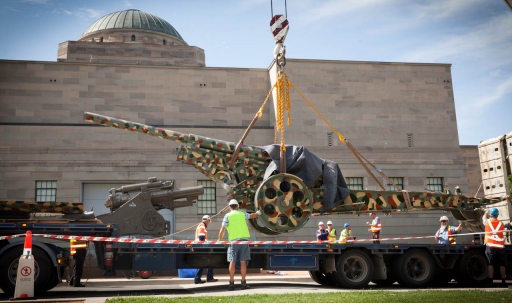Two rare surviving examples of First World War artillery have gone on display outside the Australian War Memorial in Canberra to mark the Centenary.
The 9.2inch howitzer and a German 15cm Kanone 16, captured by Australian troops at the start of the victorious Allied offensive in 1918, have been installed in AWM’s sculpture garden.
The howitzer was the largest mobile field artillery gun used by the armies of the British Empire and the United States during the Great War.
It fired a 130kg (287lbs) projectile up to 9.2 km (six miles). Although stable and accurate, the gun was difficult to move and to emplace, and had to be broken up into three separate loads for travelling.
The barrel formed one load, the top carriage and cradle the second load, and the platform the third.
When emplaced, the howitzer platform was secured onto three large section wooden firing beams which were sunk into the ground and used as a foundation for the weapon.
A large steel earth box, containing nine tonnes of soil, was fastened to the gun platform to help absorb the recoil.
Australian troops man a 9.2in Howitzer of the 2nd Australian Siege Battery (55th Australian Siege Artillery Battery) in action near Ypres (Photo: courtesy of the Australian War Memorial E00691/Public Domain)
The Australian War Memorial’s howitzer is the only known surviving production model.
It emerged largely unscathed from the war, although there are at least two impact perforations on the left hand side of the carriage.
Lined up with the howitzer is a 15cm Kanone 16, produced by the German armaments giant, Krupp.
Developed as a long-range, high-velocity weapon, it was used in both Palestine and in France, and was well regarded by the Allies for its accuracy.
The Kanone 16 fired a 52kg (115lbs) shell up to 22.8kms (14 miles). However, like all heavy artillery, it was awkward to move and designed for dismantling
The AWM’s example was seized by the 45th Battalion, Australian Imperial Force, near Morcourt in France after being damaged by shell fire.
It was one of 29 guns and over 400 prisoners captured by the battalion at the start of the Allied offensive on August 8th 1918, which became known as the ‘black day of the German Army’.
The camouflage painted on the gun is modern, but follows the original scheme. It was designed to blend the gun with the foliage of northern France in late summer/early autumn.
AWM’s Kanone 16 is the most intact of only five surviving examples in the world
Both First World War artillery pieces are displayed with a Queensland warship gun, pre-dating the federation of Australia in 1901.
Information & images supplied by the Australian War Memorial
Posted by: Peter Alhadeff, Centenary News
